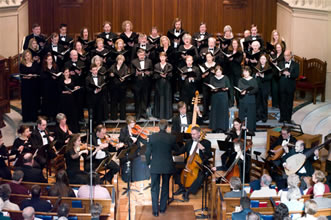There is always a good turnout in War Memorial Auditorium whenever Greensboro Symphony Orchestra Music Director Dmitry Sitkovetsky welcomes his mother, world-renowned piano virtuoso Bella Davidovich, as his guest soloist. The chemistry between them seems to bring out the best from all concerned, whether at the orchestra concert or at the intimate chamber music setting of the Sitkovetsky and Friends series. Refined playing was the theme of this evening of all Romantic music that found unexpected youthful ardor in an old warhorse.
Sitkovetsky’s interpretations are usually well within prevailing standards but this program found him hewing his own path within that range. His marginally faster tempos brought a welcome urgency to Symphony No. 8 in B minor, D. 759, “Unfinished” by Franz Schubert (1797-1828). The first movement was held firmly together while giving full value to sudden, wide changes in dynamics or tempo. The horn section, led by Robert Campbell, was in top form with some especially gorgeous, long-held notes in the second movement. That movement’s plaintive clarinet melody was eloquently phrased by Kelly Burke. Sitkovetsky is still an international violin virtuoso and this mastery is evident in the enormous strides the GSO strings continue to make. This work brought out the most palpable hushed pp string playing to date.
The First Piano Concerto in G minor, Op. 25 of Felix Mendelssohn (1809-47) has several unusual features. The soloist enters brilliantly after a short seven bars of orchestral introduction, and brass are present only in the outer two contiguous movements, sandwiching a virtual “Song Without Words” for keyboard and low strings. Sitkovetsky provided a subtly balanced accompaniment for Bella Davidovich who had plenty of power to ride over the orchestra in the outer fast movements. Her articulation of the fastest passages was remarkable as was her refined palette of dynamics and color. The interplay between her singing line and that of the violas and cellos in the middle movement was breathtaking.
Sitkovetsky was at his most individual in his approach to Symphony No. 3 in F, Op. 90 by Johannes Brahms (1833-97). All of my past reviews of the piece have been encapsulated by one adjective, “autumnal,” alluding to Brahms’ mood of bittersweet reflection. Slow paced interpretations, such as those by Kurt Sanderling or Bruno Walter, easily fit that critical mold and so have most of the many live performances I have heard over three decades. Well, Sitkovetsky’s view of Brahms’ Third still has plenty of sap in it! The intensity and dynamism he brought to it made it seem more closely related to the composer’s stormy First Symphony. It was like being splashed by a bucket of ice water and being made to hear what had seemed a well-worn “warhorse” as if it were for the first time. Sitkovetsky’s antiphonal seating of the string sections, with the first and second violins facing each other on either side of the podium, enhanced the important middle voices, violas, cellos, and woodwinds, in this symphony.











